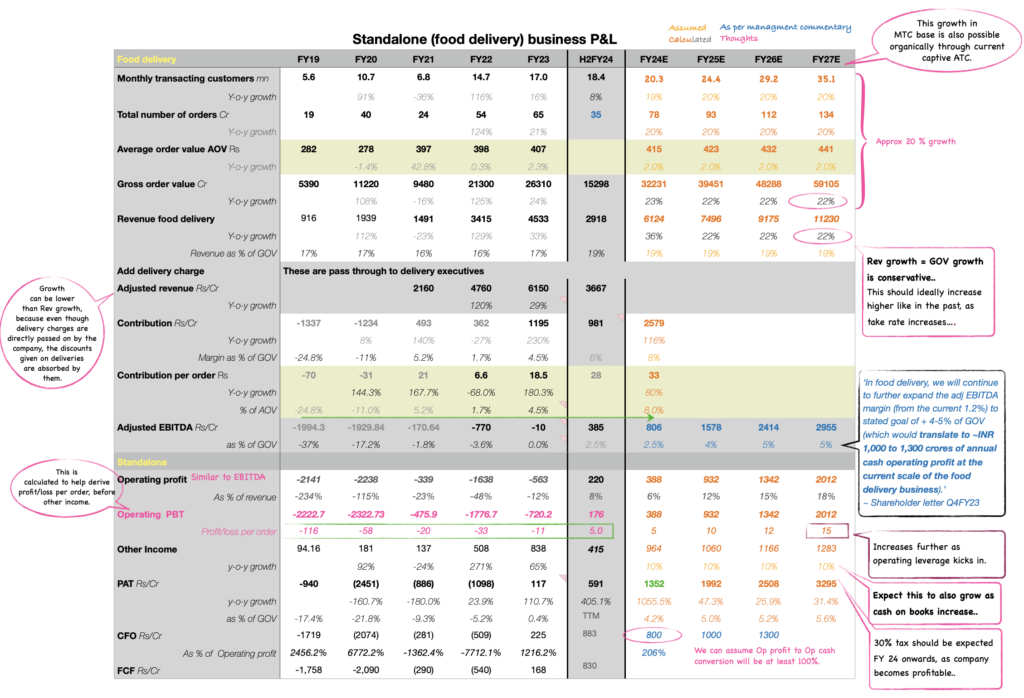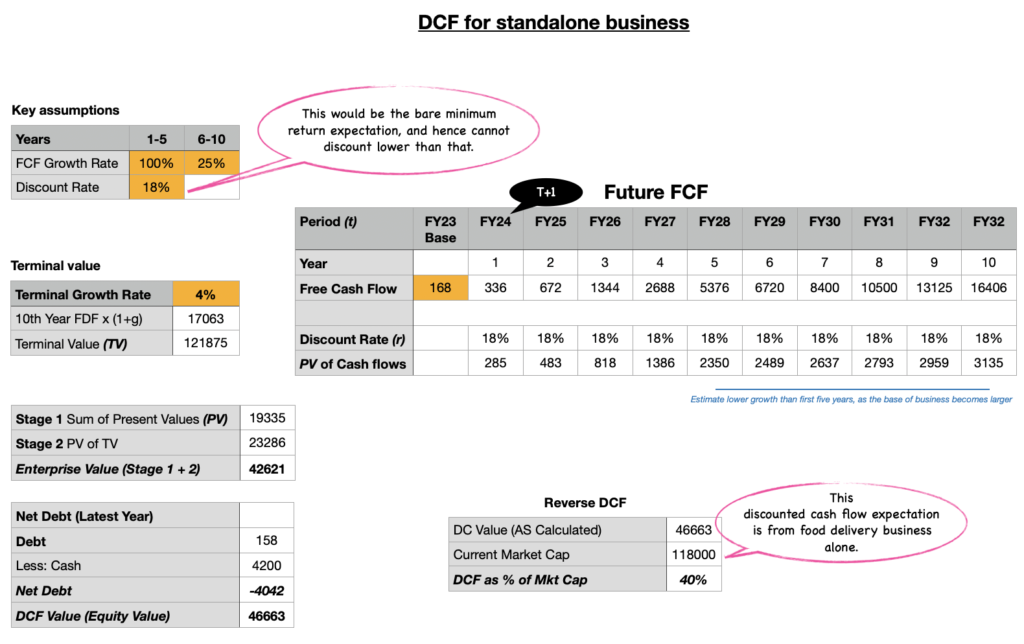Zomato’s standalone business turned positive at PAT and OCF level in Sep 22, and with sustained profitability in subsequent two quarters has resulted in the stock bottoming out at around Rs. 50 in March 23. Creating my screen shot of growth expectation for the Standalone (food delivery) business in order to understand the present valuations, and set return expectations.
The entire analysis is based on the food delivery business alone, which form < 95% of company’s standalone business.
There are many factors suggesting sustenance and improvement of profitability in the medium term..
- Business is expected to continue with Gross Order Value (GOV) growth of greater than 20% over next 5 years. This can be expected with no of orders (volume) growth and AOV (value) growth.
Total no of orders will grow as Annual transacting customers (ATC) order more frequently monthly; currently no of monthly transacting customers (MTC) are 1.8 Cr ie 30% of ATC (6 Cr). Growth would also come with increase in frequency of ordering by these customers, plus with new customers getting added. While increased penetration would come from macros like changing food habits and increase in per capita income.
AOV growth coming with increase in order size, adjusting for hike in food prices taken by restaurants and increase in delivery charges by the platform.
- As the business mature Take rates (% of GOV which the business keeps for itself) increases, thus increasing the Revenue of the business. It comes from two components and the optionalities for which should also improve as the business matures.
Restaurant – They already earn a good commission from the business and up until now it has been the primary source of revenue for the business.
Delivery platform – For the first time introduced delivery charges of Rs. 2 in Aug and hence delivery also started contributing to the take rate. The platform is also adopting dynamic platform usage fees on days of higher demand (like we saw on 2024 new years eve).
-
Advertisement income which has 90-95% margin is 3-3.5% of GOV currently, any increase flows directly into the bottomline.
-
Improvement in per order economics.Contribution per order has turned positive now and should increase further; as take rates grow, advertisement income increases, while at the same time promotions and discounts for client acquisition reduces.Operating earnings per order has reached Rs. 5 per order, expect it reach Rs. 10 in coming quarter and improve further from there on as operating leverage shows up in fixed costs.
- Operating cash generation should be expected higher or in line with PBT, as the company has -ve working capital cycle and ESOP expense will also get added back. Sustained FCF growth as future reinvestment in the vertical would be limited.
- ROCE improvement from here on, as the business would not have a requirement to raise capital through equity (other than the stock option dilution) or debt and returns are expected to be good. Expect it to be a high ROCE business upon maturity.

And that business will remain part of a duopoly..
With network effect and immense customer habit data, even a deep pocketed new player will find it difficult to sustain. Already saw that in case of Uber eats and Amazon.
With high terminal growth ..
As market penetration is low currently. Frequency of ordering and average order value is expected to grow as per capita income increases. Thus it bodes very well with the India growth story and the changing habits which comes along with that.
But as the stock has run up 160% since March 23, with a market cap close to Rs.1,17,000 Cr. Hence, it is important to understand the valuations at which they are currently trading at..

The ESOP cost taken is in the standalone business which is already turning positive at PAT level without making any adjustments.
Leading to which the business has shown profitability at consolidated PAT level in last two quarters. If Blinkit also break’s even by Q1FY25 based on managment’s commentary, the drag on consolidated PAT will also stop.. Hence we can assume the standalone PE as consolidated PE and give 1x P/E to Blinkit business, and assume the full valuation is adjusted for the food delivery business for now…
With visibility of profitability and FCF generation in the food delivery business over medium to long term, a DCF could give us a good picture of how much discount the business is currently available at..

Even at a minimal discount rate of 18%; the current price factors in about 80% CAGR in FCF over next 10 years at a terminal growth rate of 4%.
For my investment to stay secure or bore returns 18% or higher..
- FCF growth in Year 6-10 must increase above the expected 25%
- Blinkit contribution to profitability and FCF would be required.
So investing at this stage I see a medium term chance of losing money if the managment guidance of ‘Rs. 1000 to 1300 Cr OCF or blink it break even do not come through’.
Anti-thesis
My avg buying price of Rs. 129 has no margin of safety, but as there is momentum in price (which is expected to sustain as the operating leverage shows up and there is visibility PAT and FCF growth) I will hold on to the 50% position I have built and double up if I get it at a 20% discount of my current buy .
I will book profits or exit if the cash generation is not higher than my analysis at consolidated over next 6 quarters; as my actual return expectation is higher than the 18% discount taken.